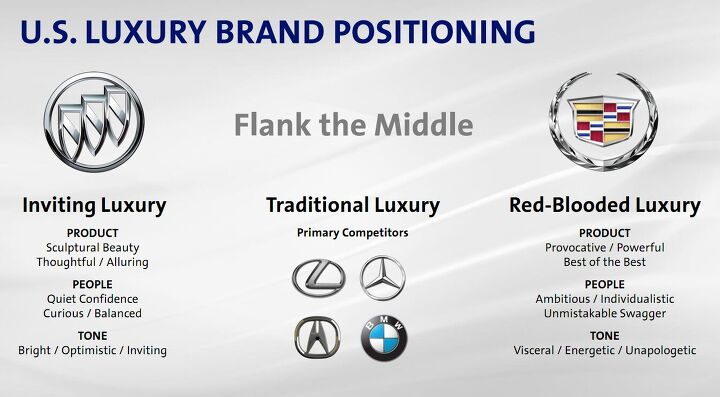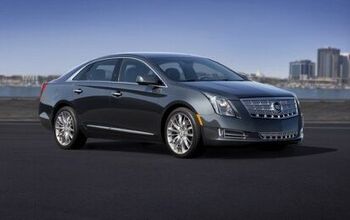Cadillac XTS: The High-Tech… Livery Car?
Though we haven’t even seen a production version yet, Cadillac’s forthcoming XTS has already lived a full, controversy-laden life. Initially suggested as a replacement for the DTS/STS, the Cadillac faithful quickly recoiled at the idea of a luxury “flagship” based on a stretched version of the Epsilon II midsized platform that underpins the Buick LaCrosse and Chevrolet Malibu. But with the Cadillac Ciel Concept showing the way forward for a “true” Caddy flagship which will eventually become the brand’s standard-bearer, the XTS’s role has been somewhat redefined. Expectations for the XTS were walked back by GM CEO Dan Akerson, who famously said that it was
not going to blow the doors off, but will be very competitive
And this week the enigma that is the XTS only deepened, as Cadillac announced two bits of seemingly contradictory information about it: first, that it would spearhead a new high-tech interface (see video above) and second, that it would mark GM’s return to the livery car business.
Cadillac’s CUE system will debut on both the XTS, ATS and 2013 SRX, all of which debut next year. You can find out more about it by watching the video above, but according to a GM presser, the system will offer several industry “firsts” including
Proximity Sensing: As the user’s hand approaches the LCD screen, command icons appear. Icons can be customized and arranged by consumers to improve ease of use.
Haptic Feedback: Buttons on the fully capacitive faceplate pulse when pressed to acknowledge the driver’s commands and helps keep the driver’s eyes on the road.
Multi-Touch Hand Gestures: interactive motions (tap, flick, swipe and spread) popularized by smartphones and tablets allow tasks on the LCD screen, such as scrolling lists, zooming maps and searching favorites to be easily accomplished.
12.3 in. LCD reconfigurable gauge cluster (on select models) offers four selectable displays – Simple, Enhanced, Balanced and Performance – that can mix traditional vehicle data such as a speedometer and fuel gauge with navigation, entertainment and 3D vehicle image.
Natural Speech Recognition lets consumers speak logically with fewer specific commands to recall stored media or input navigation destinations. CUE’s text-to-speech feature will also allow consumers to receive text messages by system voice and to send recorded text messages in return.
Linux operating system, “open” software platform and ARM 11 3-core processor, each operating at 400 million of instructions (mips) per second. This hardware setup offers 3.5 times more processing power than current infotainment systems, and allow developers to write applications to CUE that be downloaded by consumers.
Though not unique to the XTS, GM is using the forthcoming model to highlight the system, and has released pictures of the production interior. Which makes a certain amount of sense, considering that Cadillac has long considered the XTS an “inside-out” design, focusing on luxurious appointments rather than dynamic performance or bold exterior looks. And that emphasis continues, as XTS marketing manager Patrick Nally tells Automotive News [sub]
A lot of people will not consider Cadillac that buy Mercedes or BMW… We will really impress people vis-a-vis the back seats of those cars.
Now, you might think that quote, with its import-conquering swagger, might be emphasizing how well Nally expects the XTS to do on the retail market… but it’s not. Quite the contrary, as it turns out. Here’s the full passage:
Speaking of the XTS, Nally said “the black car business is important to us.”
“A lot of people will not consider Cadillac that buy Mercedes or BMW,” he said. “They do not put us on their shopping list. There is an opportunity to get the right people in the vehicle who would not otherwise” be sitting in a Cadillac.
Nally said the appointments in the livery model will be nearly identical to the high-quality appointments in the retail version of the XT
In other words, the XTS is going to conquer the consumer market, by replacing the now-extinct Town Car as the livery car of choice… and given that its main competition will be a version of the Lincoln MKT, it might just have an opportunity on its hands. Assuming, of course, that private consumers are going to want to buy a vehicle that they mainly know from livery fleets. Fleet-sales-as-marketing is a ploy we hear fairly regularly, but thus far there’s not a lot of evidence that it works especially well. Particularly in the luxury space, where exclusivity is an important factor. But I suppose that this is what Cadillac meant when it said the XTS would replace the DTS and STS… it’s not a true exclusive flagship, but an everyday luxury car with a cosseting interior.
Automotive News [sub] says that “the chopping and stretching” of the ATS will “be handled by approved coachbuilders,” and it’s likely already underway. In fact, earlier this week when I was at Milford Proving Grounds, I not only saw several camo’d XTS prototypes testing, but also what appeared to be a long-wheelbase mule with a stretched Buick LaCrosse body. Whether it was a stretched XTS mule or a China-bound LaCrosse long-wheelbase model wasn’t clear, but it seems safe to say that the Epsilon II platform is going to spawn some form of LWB sedan. And, with expectations for the XTS already blunted by its humble underpinnings and Akerson’s seeming diss, a stolid, interior-centric, fleet-oriented model seems to be a logical approach for the XTS. Too bad that orientation is a bit at odds with Cadillac’s dynamically-driven “Red Blooded Luxury” branding approach.
More by Edward Niedermeyer
Latest Car Reviews
Read moreLatest Product Reviews
Read moreRecent Comments
- ToolGuy TG likes price reductions.
- ToolGuy I could go for a Mustang with a Subaru powertrain. (Maybe some additional ground clearance.)
- ToolGuy Does Tim Healey care about TTAC? 😉
- ToolGuy I am slashing my food budget by 1%.
- ToolGuy TG grows skeptical about his government protecting him from bad decisions.



































Comments
Join the conversation
I don't want any of that touch screen or voice activated silliness in my car, not even a little bit, but I know there are folks who do. I'm trying to figure out the tone of this story which somehow seems to be suggesting it is WRONG to offer up to date features on a car, to make it appealing to retail customers, and also market it to livery buyers. If Ford had been doing that the past several years, there would be a 2012 Town Car.
Hmm those icons sure do look a lot like the ones in the Pioneer Z series of aftermarket HU's. Plus that whole "swipeability" thing also. Frankly, I can't stand OEM radios & of the new cars I have purchased, they have been banished by the 3rd day or so. I would imagine that GM would charge some 10 grand for that hi-tech screen. http://avic411.com/index.php?/gallery/image/162-legacy045/